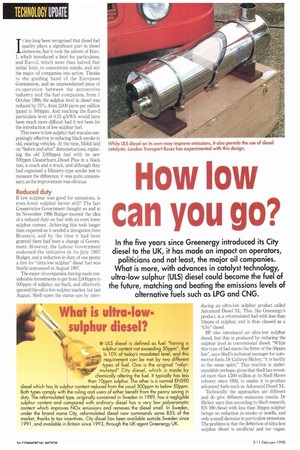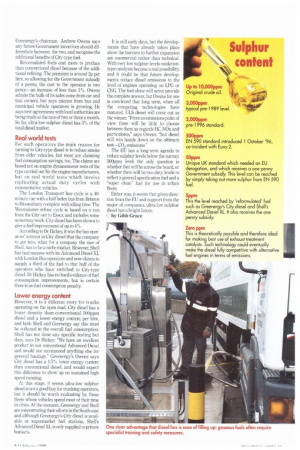How low can you go?
Page 38

Page 39

If you've noticed an error in this article please click here to report it so we can fix it.
In the five years since Greenergy introduced its City diesel to the UK, it has made an impact on operators, politicians and not least, the major oil companies. What is more, with advances in catalyst technology, ultra-low sulphur (ULS) diesel could become the fuel of the future, matching and beating the emissions levels of alternative fuels such as LPG and CNG. It has long been recognised that diesel fuel quality plays a significant part in diesel emissions, but it took the advent of Euro1, which introduced a limit for particulates, and Euro-2, which more than halved that initial limit, to concentrate minds, and stir the major oil companies into action. Thanks to the guiding hand of the European Commission, and an unprecedented piece of co-operation between the automotive industry and the fuel companies, from 1 October 1996, the sulphur level in diesel was reduced by 75%, from 2,000 parts per million (ppm) to 500ppm. And reaching the Euro-2 particulate level of 0.15 g/kWh would have been much more difficult had it not been for the introduction of low sulphur fuel.
This move to low sulphur fuel was also surprisingly effective in reducing black smoke in old, existing vehicles. At the time, Mobil laid on "before and after" demonstrations, replacing the old 2,000ppm fuel with its new 500ppm Cleanerburn,Diesel Plus in a black taxi, a coach and a truck, and although they had organised a Ministry-type smoke test to measure the difference, it was quite unnecessary, as the improvement was obvious.
Reduced duty
If low sulphur was good for emissions, is even lower sulphur better still? The last Conservative Government thought so and in its November 1996 Budget mooted the idea of a reduced duty on fuel with an even lower sulphur content. Achieving this took longer than expected as it needed a derogation from Brussels, and by the time it had been granted there had been a change of Government. However, the Labour Government endorsed the initiative in its July 1997 Budget, and a reduction in duty of one penny a litre for "ultra-low sulphur" diesel fuel was finally announced in August 1997.
The major oil companies, having made considerable investments to get from 2,000ppm to 500ppni of sulphur, sat back, and effectively ignored this ultra-low sulphur market, but last August, Shell upset the status quo by intro ducing an ultra-Vow sulphur product called Advanced Diesel XL. This, like Greenergy's product, is a reformulated fuel with less than lOppm of sulphur, and is thus classed as a "City" diesel.
BP also introduced an ultra-low sulphur diesel, but this is produced by reducing the sulphur level in conventional diesel. "While this type of fuel meets the letter of the 50ppm law", says Shell's technical manager for automotive fuels, Dr Cathryn Hickey, "it is hardly in the same spirit." This reaction is understandable perhaps, given that Shell has invested more than .1.200 million at its Shell Haven refinery since 1992, to enable it to produce advanced fuels such as Advanced Diesel XL.
Technically the approaches are different and do give different emissions results. Dr Hickey says that according to Shell research, EN 590 diesel with less than 5Oppni sulphur brings no reduction in smoke or smells, and only a small decrease in particulate emissions. The problem is that the definition of ultra-low sulphur diesel is unofficial and too vague. Greenergy's chairman Andrew Owens says any future Government incentives should differentiate between the two, and recognise the additional benefits of City-type fuel.
Reformulated fuels cost more to produce than conventional diesel because of the additional refining. The premium is around 3p per litre, so allowing for the Government subsidy of a penny, the cost to the operator is two pence—an increase of less than 1%. Owens admits the bulk of its sales come from car and taxi owners, but says interest from bus and municipal vehicle operators is growing. He says new agreements with local authorities are being made at the rate of two or three a month. So far, ultra-low sulphur diesel has 3% of the total diesel market.
Real world tests
For such operators the main reason for turning to City-type diesel is to reduce smoke from older vehicles, but most are claiming fuel consumption savings, too. The claims are based not on engine dynamometer tests of the type carried out by the engine manufacturers, but on real world tests which involve replicating actual duty cycles with representative vehicles.
The London Transport bus cycle is a 40minute run with a half laden bus from Brixton to Bloomsbury complete with idling time. The Westminster refuse cycle is based on a run from the City out to Essex and includes some motorway work. City diesel has been shown to give a fuel improvement of up to 4%.
According to Dr I lickey, it was the bus operators' interest in City diesel that the company to get into, what for a company the size of Shell, has to be a niche market. However, Shell has had success with its Advanced Disel XL with London Bus operators and now claims to supply a third of the fuel to that half of the operators who have switched to City-type diesel. Dr Hickey has no hard evidence of fuel consumption improvements, but is certain there is no fuel consumption penalty.
Lower energy content
However, it is a different story for trucks operating on the open road. City diesel has a lower density than conventional 500ppm diesel and a lower energy content per litre, and both Shell and Greenergy say this must be reflected in the overall fuel consumption. Shell has not done any specific testing but then, says Dr Hickey: "We have an excellent product in our conventional Advanced Diesel and would not recommend anything else for general haulage." Greenergy's Owens says City diesel has a 1.5% lower energy content than conventional diesel, and would expect this difference to show up on sustained high speed running At this stage, it seems ultra-low sulphur diesel is not a good buy for trunking operators, but it should be worth evaluating by those fleets whose vehicles spend most of their time in cities. At the moment, Greenergy and Shell are concentrating their efforts in the South-east and although Greenergy's City diesel is available at supermarket fuel stations, Shell's Advanced Diesel XL is only supplied to private bunkers.
It is still early days, but the developments that have already taken place show the barriers to further expansion are commercial rather than technical. With very low sulphur levels oxidationtype catalysts become a real possibility, and it could be that future developments reduce diesel emissions to the level of engines operating on LPG or CNG. The fuel alone will never provide the complete answer, but Owens for one is convinced that long term, when all the competing technologies have matured, ULS diesel will come out as the winner. From an emissions point of view there will be little to choose between them as regards HC, NOx and particulates," says Owens, "but diesel will win hands down on the ultimate test—0O2 emissions."
The EU has a long-term agenda to reduce sulphur levels below the current 500ppm level: the only question is whether that will be across the board, or whether there will be two duty levels to reflect a general specification fuel and a "super clean" fuel for use in urban fleets.
Either way, it seems that given direction from the EU and support from the major oil companies, ultra low sulphur diesel has a bright future.
L by Gibb Grace
Sulphur content
Up to 10,000ppm Original crude oil.
3, ty(p)i°c(c)171 989 level. 4 1111er' 2,000ppm pre-1996 standard.
500ppm
EN 590 standard introduced 1 October '96, co-incident with Euro-2.
5OPPrn
Unique UK standard which needed an EU derogation, and which receives a one penny Government subsidy. This level can be reached by simply taking out more sulphur from EN 590 fuel.
5ppm This the level reached by 'reformulated' fuel such as Greenergy's City diesel and Shell's Advanced Diesel XL. It also receives the one penny subsidy.
Zero ppm
This is theoretically possible and therefore ideal for making best use of exhaust treatment catalysts. Such technology could eventually make the diesel Fully competitive with alternative fuel engines in terms of emissions.








































































































